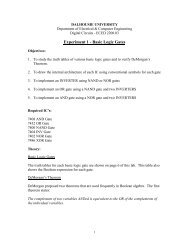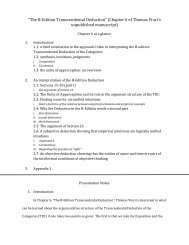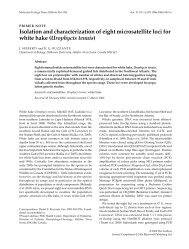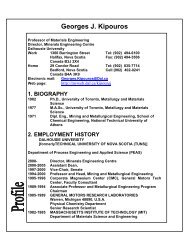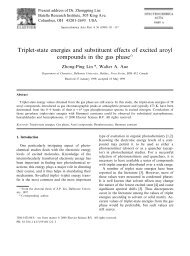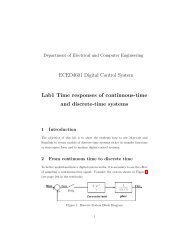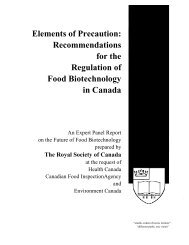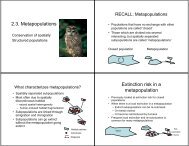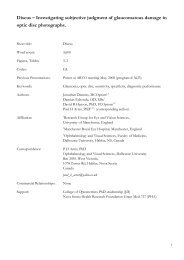Cross-Links between Thymine and Tryptophan Radical: Possible ...
Cross-Links between Thymine and Tryptophan Radical: Possible ...
Cross-Links between Thymine and Tryptophan Radical: Possible ...
You also want an ePaper? Increase the reach of your titles
YUMPU automatically turns print PDFs into web optimized ePapers that Google loves.
Prof. Dr. Petar M. Mitrasinovic<br />
Dr. Mitrasinovic (1968- ) is a professor at the Indian Institute of Technology Roorkee, India,<br />
a professor at the Belgrade Institute of Science <strong>and</strong> Technology, Serbia, a visiting professor at<br />
Wakayama University, Japan, <strong>and</strong> an invited professor at several universities in Japan (University<br />
of Tokyo, Kyoto University, Nagoya University, Tokyo Medical <strong>and</strong> Dental University, RIKEN<br />
Institute), Europe <strong>and</strong> Canada.<br />
He earned his B.Sc., Dipl.Ing.-Master (1993) in control engineering <strong>and</strong> magister (1995) in<br />
materials science <strong>and</strong> nanotechnology from the University of Belgrade, Serbia. In his magister’s<br />
thesis, a new methodology for C60 commercial production has been proposed. Several years later, in<br />
the United States of America (USA), the laser-based C60 synthesis has been optimized in terms of<br />
achieving the highest yields <strong>and</strong> production rates.<br />
He obtained his Ph.D. (2002) in chemistry from Florida State University, USA, where he<br />
was employed as lecturer. In his doctoral dissertation, the structure of isolated atoms <strong>and</strong> their<br />
chemistry forming molecules have been shown to be a physical consequence of the wave-like<br />
nature of an electron <strong>and</strong> a novel concept, the delocalization shell-like structure of electrons, has<br />
been introduced. In this way, an official underst<strong>and</strong>ing relating traditional shells to atoms, not to the<br />
behavior of electrons, <strong>and</strong> present in most of the university textbooks in physics <strong>and</strong> chemistry has<br />
been disputed.<br />
During 2002, Dr. Mitrasinovic was a European Union Research Fellow at the University of<br />
Mons-Hainaut, Belgium. His work in Belgium has fundamentally established the quantum theory of<br />
atoms in molecules (QTAIM) as an invaluable tool for investigating surface chemistry problems<br />
<strong>and</strong> has employed the theory to determine the nature of the interfacial interactions <strong>between</strong> organic<br />
molecules <strong>and</strong> metallic surfaces from the physically meaningful st<strong>and</strong>points.<br />
During 2003 <strong>and</strong> 2004, Dr. Mitrasinovic was an Izaak Walton Killam Fellow at Dalhousie<br />
University, Halifax, Canada. He has successfully developed reaction mechanisms for the crosslinking<br />
of DNA <strong>and</strong> tryptophan-containing peptides by ionizing radiation <strong>and</strong> has determined the<br />
physical conditions influencing a most likely reaction pathway. In addition, his new insights into the<br />
electronic basis of donor-acceptor interactions have placed the chemistry of donor-acceptor<br />
molecules on a more rational ground.<br />
During 2005, Dr. Mitrasinovic was an IBM Research Scientist at Henri Poincare University,<br />
Nancy, France. His work in France resulted in proposing the possible ways of resolving structural<br />
ambiguities related to the flexibility of the sugar-phosphate backbone of RNA in a 2.5-3 Ang.<br />
resolution range, which is typically attainable by experiment in case of large biologically relevant<br />
nucleic acids.<br />
Dr. Mitrasinovic was an associate professor of biophysics (2006-8) in the Center for<br />
Multidisciplinary Studies, University of Belgrade, Serbia. His research team has elucidated the most<br />
essential phenomena underlying the radioresistance of prostate carcinoma cells to ionizing radiation<br />
at the molecular level. Shortly afterwards, he has elucidated the molecular mechanism of the<br />
resistance of avian (H5N1) influenza A virus neuraminidase to the action of oseltamivir (Tamiflu) -
the most effective currently approved drug. Consequently, he has proposed the chemical structures<br />
of two new H5N1 neuraminidase inhibitors aimed to circumvent Tamiflu resistance.<br />
His group is currently engaged in the modeling of a variety of biomolecular complexes that<br />
are relevant for envisioning the more creative strategies for the design <strong>and</strong> development of novel<br />
anti-HIV drugs <strong>and</strong> anti-cancer agents.<br />
Prof. Mitrasinovic has published more than 50 original scientific articles (of which 15 as a<br />
single author) <strong>and</strong> 15 review papers in leading international journals, 6 book chapters <strong>and</strong> 6 books<br />
in chemistry, biophysics, drug design, bioinformatics, materials science, <strong>and</strong> nanotechnology. He<br />
has been plenary/invited speaker at numerous meetings, universities <strong>and</strong> institutes worldwide. He is<br />
Guest Editor of Current Organic Chemistry <strong>and</strong> of Current Bioinformatics, Academic Editor of<br />
British Journal of Pharmaceutical Research, Editor of Biomedical Science <strong>and</strong> Engineering,<br />
reviewer for prestigious international scientific journals <strong>and</strong> agencies, <strong>and</strong> is currently serving on<br />
editorial boards of 4 international journals.<br />
Prof. Mitrasinovic has been elected Full Member of the European Society of Computational<br />
Methods in Science <strong>and</strong> Engineering since 2005 <strong>and</strong> the recipient of several international<br />
recognitions: the Izaak Walton Killam Memorial Award (2003-04) from Dalhousie University,<br />
Canada, in recognition of outst<strong>and</strong>ing academic achievements, the Indian National Science<br />
Academy Professorship (2009-12), the Japan Society for the Promotion of Science Professorship<br />
(2011-12) <strong>and</strong> the International Scientist of the Year 2008 Award from the International Bio-center<br />
in Cambridge, UK.



